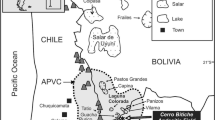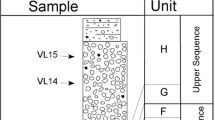Abstract
We examined the evolution of the magma feeding system at Zao volcano (NE Japan) during seven episodes of Komakusadaira pyroclastic activity (ca. 33–12.9 ka). The rocks, which are calc-alkaline and medium-K basaltic andesite to andesite (54.9–59.5% SiO2), are herein suggested to have been derived from two main magmatic end-members: silicic andesite magma (59~60% SiO2, 940~970°C, cpx-opx-plg as phenocrysts) and basaltic magma (52% SiO2, ~ 1085°C, Fo78~80 olv-plg as phenocrysts). These two end-members retained their compositional integrities throughout all seven eruptive episodes. The presence of Mg-rich (Fo> 80) olivine phenocrysts suggests the basaltic end-member was derived from fairly primitive magma (> 1100°C), which differentiated during ascent. By examining temporal variations in the chemical compositions of the phenocrystic minerals, three evolutionary pathways that produced the erupted products are defined; these are reflected in seven sequential episodes: (1) Crystal-rich silicic andesite magma was repeatedly withdrawn from the reservoir by the forced injection of basaltic magma (episode 1). (2) Crystal-poorer intermediate magma was formed by effective mixing of injected basaltic magma. Subsequent eruption of the intermediate magma was triggered by a new injection of mafic magma. The percentage of intermediate magma involved in the eruptions decreased over time (episodes 2–4). (3) By repeated fairly primitive to basaltic magma injections, the percentage of the mobilized part of the silicic andesite magma involved in the erupted magma gradually increased over time (episodes 5–7).










Similar content being viewed by others
References
Amma-Miyasaka M, Nakagawa M (2003) Evolution of deeper basaltic and shallower andesitic magmas during the AD 1649-193 eruptions of Miyake-Jima volcano, Izu-Mariana arc: Inferences from temporal variation of mineral compositions in crystal-clots. J Petrol 44:2113–2138
Andújar J, Scaillet B, Pichavant M, Druitt TH (2016) Generation conditions of dacite and rhyodacite via the crystallization of an andesitic magma. Implications for the plumbing system at Santorini (Greece) and the origin of tholeiitic or calc-alkaline differentiation trends in arc magmas. J Petrol 57:1887–1920
Ban M, Yamamoto T (2002) Petrological study of Nasu-Chausudake Volcano (ca. 16 ka to Present), northeastern Japan. Bull Volcanol 64:100–116
Ban M, Sagawa H, Miura K, Hirotani S (2008) Evidence for a short lived stratified magma chamber: petrology of the Z-To 5 tephra layer (c. 5.8ka) at Zao volcano, NE Japan. In: Annen C, Zellmer GF (eds) Dynamics of crustal magma transfer, storage and differentiation. Geological Society, London, Special Publications 304:149–168
Ban M, Oikawa N, Yamazaki S (2015) Geological map of Zao volcano. Geological survey of, Japan, AIST
Brey G, Köhler T (1990) Geothermobarometry in four-phase lherzolites II. New thermobarometers, and practical assessment of existing thermobarometers. J Petrol 31:1353–1378
Cashman KV, Sparks RSJ, Blundy JD (2017) Vertically extensive and unstable magmatic systems: a unified view of igneous processes. Science 355:eaag3055
Cioni R, Civetta L, Marianelli P, Métrich N, Santacroce R, Sbrana A (1995) Compositional layering and syneruptive mixing of a periodically refilled magma chamber: the AD 79 Plinian eruption of Vesuvius. J Petrol 36:739–776
Gill JB (1981) Orogenic andesites and plate tectonics. Springer-Verlag, Berlin, pp 1–392
Goode ADT (1974) Oxidation of nature olivine. Nature 248:500–501
Gualda GAR, Ghiorso MS, Lemons RV, Carley TL (2012) Rhyolite-MELTS: a modified calibration of MELTS optimized for silica-rich, fluid-bearing magmatic systems. J Petrol 53:875–890
Hildreth W (2004) Volcanological perspectives on Long Valley, Mammoth Mountain, and Mono Craters: several contiguous but discrete systems. J Volcanol Geotherm Res 136:169–198
Humphreys MCS, Blundy JD, Sparks RSJ (2006) Magma evolution and open-system processes at Shiveluch volcano: insights from phenocryst zoning. J Petrol 47:2303–2334
Iacovino K, Till CB (2019) DensityX: a program for calculating the densities of magmatic liquids up to 1,627 °C and 30 kbar. Vulcanica 2:1–10
Lofgren G (1974) An experimental study of plagioclase crystal morphology: isothermal crystallization. Am J Sci 274:243–273
Manrique N, Samaniego P, Médard E, Schiavi F, Mariño J, Liorzou C (2019) Pre-eruptive magmatic processes associated with the historical (218 ± 14 aBP) explosive eruption of Tutupaca volcano (southern Peru)
Marsh BD (1989) Magma chambers. Ann Rev Earth Planet Sci 17:439–474
Matsui Y, Nishizawa O (1974) Iron (II)-magnesium exchange equilibrium between olivine and calcium-free pyroxene over a temperature range 800°C to 1300°C. Bull Soc Fr Mineral Cristallogr 97:122–130
Miyashiro A (1974) Volcanic rock series in island arcs and active continental margins. Am J Sci 274:321–355
Nakamura M (1995) Continuous mixing of crystal mush and replenished magma in the ongoing Unzen eruption. Geology 23:807–810
Nicotra E, Viccaro M, De Rossa R, Sapienza M (2014) Volcanological evolution of the Rivi–Capo Volcanic Complex at Salina, Aeolian Islands: magma storage processes and ascent dynamics. Bull Volcanol 76:840
Obata M, Banno S, Mori T (1974) The iron-magnesium partitioning between naturally occurring coexisting olivine and Ca-rich clinopyroxene: an application of the sample mixture model to olivine solid solution. Bull Soc Fr Mineral Cristallogr 97:101–107
Pearce TH (1994) Recent work on oscillatory zoning in plagioclase. In: Parson I (ed) Feldspars and their reactions. Kluwer, Dordrecht, pp 313–349
Putirka KD (2017) Down the crater: where magmas are stored and why they erupt. Elements (2017) 13:11–16
Sack RO, Carmichael ISE, Rivers M, Ghiorso MS (1981) Ferric-ferrous equilibria in nature silicate liquids at 1 bar. Contrib Mineral Petrol 75:369–376
Sisson TW, Grove TL (1993) Experimental investigations of the role of H2O in calc-alkaline differentiation and subduction zone magmatism. Contrib Mineral Petrol 113:143–166
Sparks RSJ, Annen C, Blundy JD, Cashman KV, Rust AC, Jackson MD (2019) Formation and dynamics of magma reservoirs. Phil Trans R Soc A 377:20180019
Takeuchi S, Nakamura M (2001) Role of precursory less-viscous mixed magma in the eruption of phenocryst-rich magma: evidence from the Hokkaido-Komagatake 1929 eruption. Bull Volcanol 63:365–376
Tsuchiyama A (1985) Dissolution kinetics of plagioclase in the melt of the system diopside-albite-anorthite, and origin of dusty plagioclase in andesites. Contrib Mineral Petrol 89:1–16
Viccaro M, Giacomoni PP, Ferlito C, Cristofolini R (2010) Dynamics of magma supply at Mt. Etna volcano (Southern Italy) as revealed by textural and compositional features of plagioclase phenocrysts. Lithos 116:77–91
Acknowledgments
Many critical comments and suggestions from Drs. J. Fierstein, K. Chamberlain, K. Iacovino, R. Cioni, M. Nakagawa, M. Viccaro, G. Sosa-Ceballos, and E. Nicotra greatly helped to revise the manuscript.
Funding
This study was supported by the funds from the MEXT of Japan (No. 22540487) and ERI JURP (2009-A-13).
Author information
Authors and Affiliations
Corresponding author
Additional information
Editorial responsibility: J. Fierstein
Rights and permissions
About this article
Cite this article
Takebe, M., Ban, M. & Nishi, Y. Evolution of the calc-alkaline magma feeding system of the Komakusadaira pyroclastics in Zao volcano, NE Japan. Bull Volcanol 83, 12 (2021). https://doi.org/10.1007/s00445-020-01430-3
Received:
Accepted:
Published:
DOI: https://doi.org/10.1007/s00445-020-01430-3




